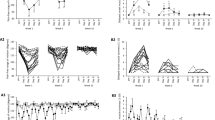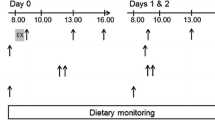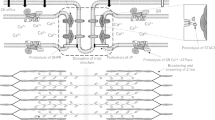Abstract
The purpose of this study was to compare the responsiveness of changes in Ca2+-content and calpain–calpastatin gene expression to concentric and eccentric single-bout and repeated exercise. An exercise group (n = 14) performed two bouts of bench-stepping exercise with 8 weeks between exercise bouts, and was compared to a control-group (n = 6). Muscle strength and soreness and plasma creatine kinase and myoglobin were measured before and during 7 days following exercise bouts. Muscle biopsies were collected from m. vastus lateralis of both legs prior to and at 3, 24 h and 7 days after exercise and quantified for muscle Ca2+-content and mRNA levels for calpain isoforms and calpastatin. Exercise reduced muscle strength and increased muscle soreness predominantly in the eccentric leg (P < 0.05). These responses as well as plasma levels of creatine kinase and myoglobin were all attenuated after the repeated eccentric exercise bout (P < 0.05). Total muscle Ca2+-content did not differ between interventions. mRNA levels for calpain 2 and calpastatin were upregulated exclusively by eccentric exercise 24 h post-exercise (P < 0.05), with no alteration in expression between bouts. Calpain 1 and calpain 3 mRNA did not change at any specific time point post-exercise for either intervention. Our mRNA results suggest a regulation on the calpain–calpastatin expression response to muscle damaging eccentric exercise, but not concentric exercise. Although a repeated bout effect was demonstrated in terms of muscle function, no immediate support was provided to suggest that regulation of expression of specific system components is involved in the repeated bout adaptation.






Similar content being viewed by others

References
Arendt-Nielsen L (2002) Clinical use of pain measurement techniques. Ugeskr Laeger 164:1790–1795
Belcastro AN (1993) Skeletal muscle calcium-activated neutral protease (calpain) with exercise. J Appl Physiol 74:1381–1386
Belcastro AN, Shewchuk LD, Raj DA (1998) Exercise-induced muscle injury: a calpain hypothesis. Mol Cell Biochem 179:135–145
Busquets S, Garcia-Martinez C, Alvarez B, Carbo N, Lopez-Soriano FJ, Argiles JM (2000) Calpain-3 gene expression is decreased during experimental cancer cachexia. Biochim Biophys Acta 1475:5–9
Chomczynski P, Sacchi N (1987) Single-step method of RNA isolation by acid guanidinium thiocyanate-phenol-chloroform extraction. Anal Biochem 162:156–159. doi:10.1006/abio.1987.9999
Dheda K, Huggett JF, Chang JS, Kim LU, Bustin SA, Johnson MA, Rook GA, Zumla A (2005) The implications of using an inappropriate reference gene for real-time reverse transcription PCR data normalization. Anal Biochem 344:141–143. doi:10.1016/j.ab.2005.05.022
Dietrichson P, Coakley J, Smith PE, Griffiths RD, Helliwell TR, Edwards RH (1987) Conchotome and needle percutaneous biopsy of skeletal muscle. J Neurol Neurosurg Psychiatry 50:1461–1467
Edwards RH, Young A, Hosking GP, Jones DA (1977) Human skeletal muscle function: description of tests and normal values. Clin Sci Mol Med 52:283–290
Feasson L, Stockholm D, Freyssenet D, Richard I, Duguez S, Beckmann JS, Denis C (2002) Molecular adaptations of neuromuscular disease-associated proteins in response to eccentric exercise in human skeletal muscle. J Physiol 543:297–306
Fluck M, Dapp C, Schmutz S, Wit E, Hoppeler H (2005) Transcriptional profiling of tissue plasticity: role of shifts in gene expression and technical limitations. J Appl Physiol 99:397–413. doi:10.1152/japplphysiol.00050.2005
Friden J, Sjostrom M, Ekblom B (1983) Myofibrillar damage following intense eccentric exercise in man. Int J Sports Med 4:170–176
Gissel H, Clausen T (1999) Excitation-induced Ca2+ uptake in rat skeletal muscle. Am J Physiol 276:R331–R339
Gissel H, Clausen T (2001) Excitation-induced Ca2+ influx and skeletal muscle cell damage. Acta Physiol Scand 171:327–334
Goll DE, Thompson VF, Li H, Wei W, Cong J (2003) The calpain system. Physiol Rev 83:731–801. doi:10.1152/physrev.00029.2002
Huang J, Forsberg NE (1998) Role of calpain in skeletal-muscle protein degradation. Proc Natl Acad Sci USA 95:12100–12105
Jackman RW, Kandarian SC (2004) The molecular basis of skeletal muscle atrophy. Am J Physiol Cell Physiol 287:C834–C843. doi:10.1152/ajpcell.00579.2003
Jonsdottir IH, Schjerling P, Ostrowski K, Asp S, Richter EA, Pedersen BK (2000) Muscle contractions induce interleukin-6 mRNA production in rat skeletal muscles. J Physiol 528(Pt 1):157–163
Kinbara K, Ishiura S, Tomioka S, Sorimachi H, Jeong SY, Amano S, Kawasaki H, Kolmerer B, Kimura S, Labeit S, Suzuki K (1998) Purification of native p94, a muscle-specific calpain, and characterization of its autolysis. Biochem J 335(Pt 3):589–596
Konig N, Raynaud F, Feane H, Durand M, Mestre-Frances N, Rossel M, Ouali A, Benyamin Y (2003) Calpain 3 is expressed in astrocytes of rat and Microcebus brain. J Chem Neuroanat 25:129–136
Larsen RG, Ringgaard S, Overgaard K (2007) Localization and quantification of muscle damage by magnetic resonance imaging following step exercise in young women. Scand J Med Sci Sports 17:76–83. doi:10.1111/j.1600-0838.2006.00525.x
Mahoney DJ, Carey K, Fu MH, Snow R, Cameron-Smith D, Parise G, Tarnopolsky MA (2004) Real-time RT-PCR analysis of housekeeping genes in human skeletal muscle following acute exercise. Physiol Genomics 18:226–231. doi:10.1152/physiolgenomics.00067.2004
Malm C (2001) Exercise-induced muscle damage and inflammation: fact or fiction? Acta Physiol Scand 171:233–239
McHugh MP (2003) Recent advances in the understanding of the repeated bout effect: the protective effect against muscle damage from a single bout of eccentric exercise. Scand J Med Sci Sports 13:88–97
Murphy RM, Goodman CA, McKenna MJ, Bennie J, Leikis M, Lamb GD (2007) Calpain-3 is autolyzed and hence activated in human skeletal muscle 24 h following a single bout of eccentric exercise. J Appl Physiol 103:926–931. doi:10.1152/japplphysiol.01422.2006
Nedergaard A, Vissing K, Overgaard K, Kjaer M, Schjerling P (2007) Expression patterns of atrogenic and ubiquitin proteasome component genes with exercise: effect of different loading patterns and repeated exercise bouts. J Appl Physiol 103:1513–1522. doi:10.1152/japplphysiol.01445.2006
Newham DJ, Jones DA, Edwards RH (1983) Large delayed plasma creatine kinase changes after stepping exercise. Muscle Nerve 6:380–385. doi:10.1002/mus.880060507
Nosaka K, Sakamoto K, Newton M, Sacco P (2001) How long does the protective effect on eccentric exercise-induced muscle damage last? Med Sci Sports Exerc 33:1490–1495
Nosaka K, Newton MJ, Sacco P (2005) Attenuation of protective effect against eccentric exercise-induced muscle damage. Can J Appl Physiol 30:529–542
Overgaard K, Fredsted A, Hyldal A, Ingemann-Hansen T, Gissel H, Clausen T (2004) Effects of running distance and training on Ca2+ content and damage in human muscle. Med Sci Sports Exerc 36:821–829
Raynaud P, Gillard M, Parr T, Bardsley R, Amarger V, Leveziel H (2005a) Correlation between bovine calpastatin mRNA transcripts and protein isoforms. Arch Biochem Biophys 440:46–53. doi:10.1016/j.abb.2005.05.028
Raynaud P, Jayat-Vignoles C, Laforet MP, Leveziel H, Amarger V (2005b) Four promoters direct expression of the calpastatin gene. Arch Biochem Biophys 437:69–77. doi:10.1016/j.abb.2005.02.026
Schjerling P (2001) The importance of internal controls in mRNA quantification. J Appl Physiol 90:401–402
Sorichter S, Mair J, Koller A, Gebert W, Rama D, Calzolari C, Artner-Dworzak E, Puschendorf B (1997) Skeletal troponin I as a marker of exercise-induced muscle damage. J Appl Physiol 83:1076–1082
Sorimachi H, Toyama-Sorimachi N, Saido TC, Kawasaki H, Sugita H, Miyasaka M, Arahata K, Ishiura S, Suzuki K (1993) Muscle-specific calpain, p94, is degraded by autolysis immediately after translation, resulting in disappearance from muscle. J Biol Chem 268:10593–10605
Spencer MJ, Lu B, Tidball JG (1997) Calpain II expression is increased by changes in mechanical loading of muscle in vivo. J Cell Biochem 64:55–66. doi:10.1002/(SICI)1097-4644(199701)64:1
Stupka N, Tarnopolsky MA, Yardley NJ, Phillips SM (2001) Cellular adaptation to repeated eccentric exercise-induced muscle damage. J Appl Physiol 91:1669–1678
Tidball JG, Spencer MJ (2002) Expression of a calpastatin transgene slows muscle wasting and obviates changes in myosin isoform expression during murine muscle disuse. J Physiol 545:819–828
Vissing K, Andersen JL, Schjerling P (2005) Are exercise-induced genes induced by exercise? FASEB J 19:94–96. doi:10.1096/fj.04-2084fje
Warren GL, Lowe DA, Armstrong RB (1999) Measurement tools used in the study of eccentric contraction-induced injury. Sports Med 27:43–59
Wei W, Fareed MU, Evenson A, Menconi MJ, Yang H, Petkova V, Hasselgren PO (2005) Sepsis stimulates calpain activity in skeletal muscle by decreasing calpastatin activity but does not activate caspase-3. Am J Physiol Regul Integr Comp Physiol 288:R580–R590. doi:10.1152/ajpregu.00341.2004
Williams AB, Decourten-Myers GM, Fischer JE, Luo G, Sun X, Hasselgren PO (1999) Sepsis stimulates release of myofilaments in skeletal muscle by a calcium-dependent mechanism. FASEB J 13:1435–1443
Yeung EW, Allen DG (2004) Stretch-activated channels in stretch-induced muscle damage: role in muscular dystrophy. Clin Exp Pharmacol Physiol 31:551–556. doi:10.1111/j.1440-1681.2004.04027.x
Acknowledgments
We wish to acknowledge the Danish Health Research Agency (grants no. 22-04-0454), the Ministry of Culture (grant no. 2004-05-029), the NovoNordisk Foundation, Hovedstadens Sygehusfaellesskab and the Medical Faculty at the University of Copenhagen. Furthermore, we would like to thank Thorsten Ingemann Hansen for clinical assistance and Anne Mette Kloster for technical assistance.
Author information
Authors and Affiliations
Corresponding author
Electronic supplementary material
Below is the link to the electronic supplementary material.
Rights and permissions
About this article
Cite this article
Vissing, K., Overgaard, K., Nedergaard, A. et al. Effects of concentric and repeated eccentric exercise on muscle damage and calpain–calpastatin gene expression in human skeletal muscle. Eur J Appl Physiol 103, 323–332 (2008). https://doi.org/10.1007/s00421-008-0709-7
Accepted:
Published:
Issue Date:
DOI: https://doi.org/10.1007/s00421-008-0709-7



